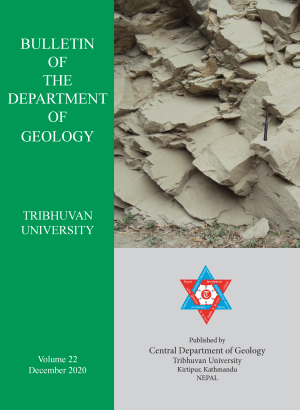Textural and mineralogical maturities and provenance of sands from the Budhi Gandaki-Narayani Nadi, central Nepal
DOI:
https://doi.org/10.3126/bdg.v22i0.33408Keywords:
Fluvial sand, Sedimentary process, Graphic measures, Textural maturity, Mineralogical maturityAbstract
The Budhi Gandaki-Narayani Nadi in the Central Nepal flows across fold-thrust belts of the Tethys Himalaya, Higher Himalaya, Lesser Himalaya, and the Sub-Himalaya, and is located in sub-tropical to humid sub-tropical climatic zone. Within the Higher Himalayas and the Lesser Himalayas, a high mountain and hilly region give way the long high-gradient, the Budhi Gandaki Nadi in the northern region. At the southern region within the Sub-Himalayas, having a wide Dun Valley, gives way the long low-gradient Narayani Nadi. Sands from Budhi Gandaki-Narayani Nadi were obtained and analysed for textural maturity and compositional maturity. The textural analyses consisted of determining roundness and sphere city of quartz grains for shape, and determining size of sand for matrix percent and various statistical measures including sorting. The analysis indicates that the textural maturity of the majority of sands lies in sub mature category though few textural inversions are also remarkable. Sands from upstream to downstream stretches of the main stem river show depositional processes by graded suspension in highly turbulent (saltation) current to fluvial tractive current, as confirmed from the C-M patterns.
The compositional variation includes quartz, feldspar, rock fragments, mica, etc. The quartz grain percent slightly increases from the mountains to the lower relief areas. The percent feldspar decreases rapidly whereas the percent rock fragment decreases gradually along the downstream transport of sediment. The Budhi Gandaki-Narayani Nadi sands range from sublitharenite to lithic arenite composition in QFL diagram, and are remarkably poorer in feldspar compared to rock fragment. Among the rock fragments, the high-grade metamorphic rock fragmentsare dominant in the upstream stretch of the main stem Narayani Nadi stretch while the sedimentary lithics are remarkable in the downstream stretch. The QFL plots also show that the studied sands belong to recycled orogeny provenance and agree with the current tectonic setting of the Himalayas. Mineralogically, the sands (MMI=100%–203%) are not as matured as the normal sands. MMI fluctuates along downstream distance due to mixing of sediments from the major tributaries at various places along the main stem river.
Downloads
Downloads
Published
How to Cite
Issue
Section
License
© Central Department of Geology, Tribhuvan University, Nepal

